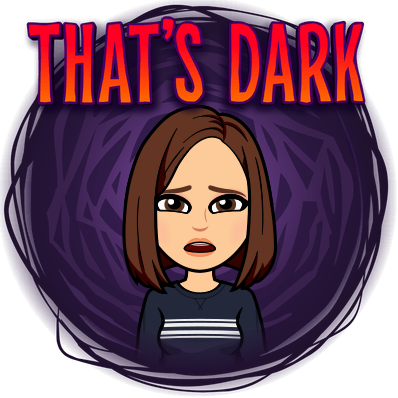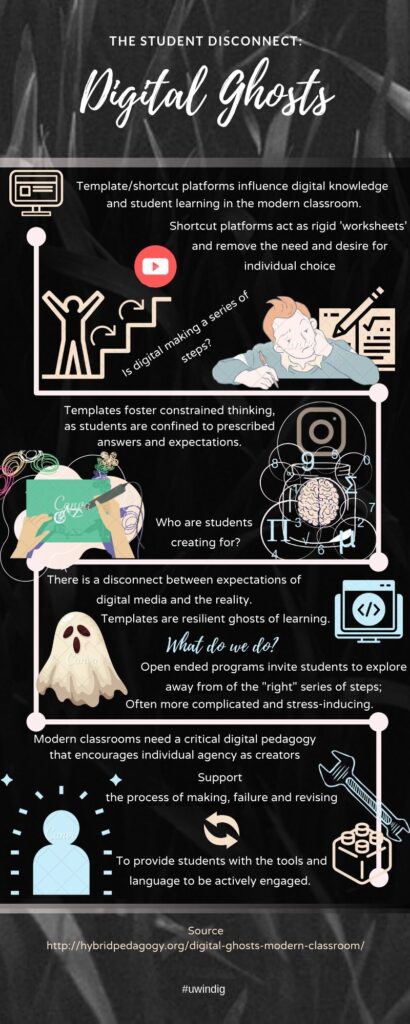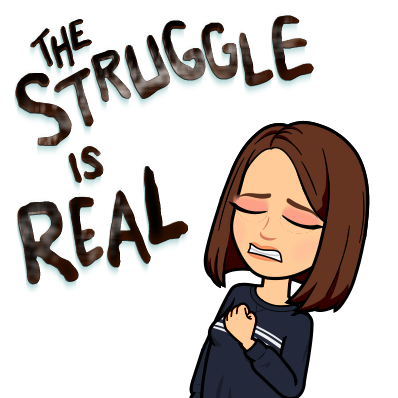I read the hybrid pedagogy article titled Digital Ghosts in the Modern Classroom by Ashley Hinck. Her article explores the use of template/shortcut platforms and how they place limitations on creativity and literacies in the classroom. To counter this, Hinck refers to a “Critical Digital Pedagogy” to positively impact the learning process for students. To summarize this article, I chose to make an infographic using Canva.

Almost immediately after delving into the article, I was able to make some quick connections. As a high-school student, I can remember taking a digital media course with the explicit purpose to learn how to create digital pieces using photoshop or HTML/CSS. I can remember the mixture of anxiety and eventual boredom I felt when I realized digital making involved more than following a set of instructions and conveniently plugging in my own ideas into a template. While this sounds obvious, this new approach in the classroom went against everything I had learned and continued to learn as a student. As such, the idea of template/shortcut platforms as ‘worksheets’ resonated with my own experiences as a student, as well as allowed me to reflect on my own pedagogical experiences. I find I am most comfortable learning and teaching in a lecture-based environment. My undergraduate program consisted of factual material that had one or few varying answers. I had not considered the implications of this, or how everyday use of media platforms can reinforce this traditional mindset of structured knowledge, rather than creativity. This ‘ghost of worksheet templates’ has real implications in our day to day learning, both as students and teachers.

In my practice, I would like to encourage learning as a process of trial and error, rather than what Hinck describes as linear steps that lead to success or failure. I think it’s really important for students to be confident in their work and achievements, as well as to be able to take constructive criticism and improve when necessary. Incorporating digital media may be one way to gain essential literacies to build on students knowledge and communicate through open and engaging methods. For example, students can recognize the limitations of template platforms and create new digital experiences that they can draw from. As well, it can provide an avenue for educators to gain new pedagogical knowledge and foster ‘good learning’ practices for which allow students to ‘try, fail and revise’. These can be applied even without digital context (i.e.: allowing a student to improve on a test they did poorly on).

In my experience with Canva, I wanted to try and create an infographic that didn’t rely heavily on using a template. However, I found myself repeatedly looking up Youtube videos on how to create a good infographic and which template styles would be the best to use. I decided on a template and tried to use this as an opportunity to see if the experience was limiting in any way. While I found it easy to navigate Canva and its ‘drag-and-drop‘ options, it was difficult to summarize the article using the available graphics. While I did change the font and choice of colours, there was not a heavy selection of images that were available to the free user. Furthermore, it was hard to deviate from the prescribed format. Alternatively, Canva allowed me to create a finished digital product that followed an easy set of steps.

In the end, I found myself worrying a lot if I was making an infographic correctly and experienced a bit of stress. Linking back to the article, I feel like even when given the opportunity to be creative, I worried that I was not following the correct format. I think this impacted my infographic, as well as my engagement with the tool as I was more worried about the finished product, rather than the process.

With a “Critical Digital Pedagogy” I am confident students will be better able to interact and engage with content, as well as recognizing the influence that platforms have on their learning and creative output.
